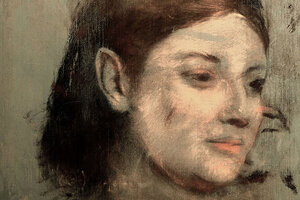Degas' mysterious portrait revealed: How X-rays help 'find' old artwork
Modern X-ray imaging technology gives art historians and scientists the opportunity to view hidden masterpieces in full color.

This undated photo provided by Australian Synchrotron and the National Gallery of Victoria shows an image appears, with X-ray fluorescence microscopy, beneath Edgar Degas' Portrait of a Woman. Staff at the National Gallery of Victoria in Melbourne, Australia, asked scientists from Australian Synchrotron to scan the painting with a high-definition X-ray beam produced by a particle accelerator called a synchrotron to unveil the image.
Australian Synchrotron and the National Gallery of Victoria/AP
In an innovative intersection between art and science, researchers used X-ray imaging and particle accelerators to uncover a mysterious portrait of a woman beneath a painting by artist Edgar Degas, according to a new study published in the journal Scientific Reports.
Art historians have known about the hidden image for years, as a dark colored stain emerged across the face of the top portrait, called “Portrait of a Woman.” It was not until recently, however, that Australian scientists worked with the National Gallery of Victoria in Melbourne to determine what was behind the present day painting.
“You get to see the personal characteristics – the painting style of Degas himself,” said paper co-author David Thurrowgood, according to the New York Times. “It gives you the feeling that you’re looking over his shoulders and watching him make the painting, which is of course long gone for the human eye. But thanks to this XRF work, it’s there again.”
What scientists discovered was the image of another young woman, likely Degas’ recent model, Emma Dobigney. Researchers determined that Degas painted the present day portrait over the top of the original without painting a base layer in between, allowing the pigments of the original portrait to leach through the top coat over the years.
Researchers used X-ray beams and a type of particle accelerator, called a synchrotron, to view a high-resolution image of the under layer. The synchrotron used an extremely concentrated beam of high energy light to scan the painting in a method called X-ray fluorescence.
This technique can determine the chemistry of a paint by measuring the fluorescent (or secondary) X-ray emitted from an element, or elements, in the paint, when it is excited by a primary X-ray source. Each of the elements produce a set of characteristic fluorescent X-rays ("a fingerprint") that is unique for that specific element, according to ThermoFisher Scientific.
Using this technique, researchers were able to detect pigments created by zinc, copper, and iron in the paint. By using their knowledge of the hues these paints would produce, researchers were able to recreate the portrait.
"By layering different element maps and introducing false colors into the image to highlight how different parts of the painting were built up with different layers of pigment,” according to Thurrowgood, “you can get a real sense of how the artist might have been mixing [pigments] and working."
A similar discovery occurred in 2008 after scientists discovered an old Van Gogh under another painting by the same artist in a museum in the Netherlands. Researchers there also used X-ray techniques to uncover the older painting underneath a Van Gogh called “Patch of Grass.”
While it may be rare for these hidden paintings to be discovered, they most likely are more common than we think. According to a 2009 Telegraph article, art historians believe that as many as 20 percent of paintings could have older paintings behind them.
The synchrotron imaging technique could help researchers discover more of these hidden treasures, as it enables researchers to map the different pigments and uncover a greater variety of colors, instead of the flat, black and white picture afforded by traditional x-ray techniques.
Researchers suggest that the discovery will boost the painting’s popularity, due to the unique nature of the discovery.
"It is a quite famous painting by Degas that isn't seen very often — it's held in a private collection, and unfortunately, it's only been shown a few times," Thurrowgood said, according to LiveScience. "So I think there's going to be a lot of interest as people discover there is another version of that painting."

